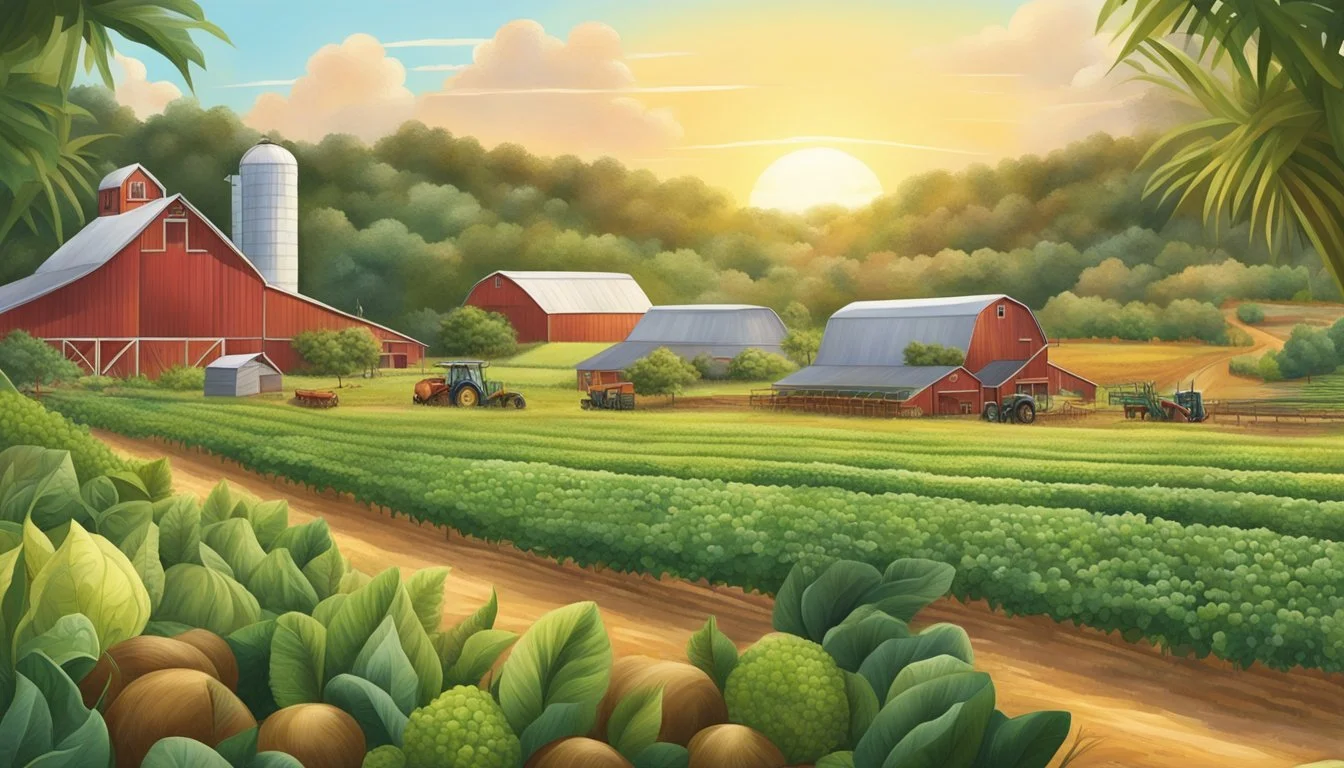Farming Communities in Florida
Innovations and Challenges
Farming communities in Florida form the backbone of the state's agricultural prowess, stretching from the verdant fields of Suwannee County in the north to the more temperate regions in the south. Agriculture in these areas is not just a tradition but a vital economic driver, providing approximately half of the jobs and regional gross product in some counties. In 2016, Florida’s agricultural sector produced 378 million pounds of broiler chickens valued at over $203 million and 2.364 billion eggs valued at $110 million.
In addition to traditional farming, innovative planned agricultural communities (PACs) like Pine Dove Farm are rising in North Florida. These communities blend eco-friendly living with agricultural production, offering spacious lots that maintain a rural, serene atmosphere. Such developments show a commitment to sustainable agriculture while catering to modern-day living needs.
The real estate market also reflects the importance of agriculture in the state, with hundreds of small farms available for sale. Whether it's hobby farms, rural mini-farms, or larger agricultural properties, Florida’s diverse farmland options cater to various agricultural pursuits, emphasizing the state's dedication to maintaining and nurturing its agricultural roots.
History of Farming in Florida
Farming has deep roots in Florida, with practices evolving significantly over the centuries. From the exploitation of native crops by the Seminole tribes to the expansive agricultural communities seen today, Florida’s farming history is rich and multifaceted.
Early Agriculture Practices
The Seminole tribes in Florida cultivated a variety of crops such as maize, beans, and squash. They also made extensive use of local estuarine resources. When Spanish explorers, led by Admiral Don Pedro Menendez de Aviles, arrived in 1565, they introduced crops like oranges, lemons, and limes, expanding the agricultural diversity.
In the 18th century, British officials acquired large land tracts, planting citrus trees and other fruit varieties, setting a precedent for commercial agriculture in the region.
Development of Farming Communities
In the late 19th and early 20th centuries, rural Florida saw a shift towards organized farming communities. Farmers grew a variety of crops, such as cotton, providing significant economic benefits. By the 2010s, counties like Suwannee had become crucial agricultural centers, with substantial outputs of broiler chickens and eggs.
Additionally, modern farming techniques and infrastructure improvements have allowed these communities to thrive, contributing to Florida's status as a key agricultural state.
Major Crops in Florida:
Crop Production (Year) Broiler Chickens 378 million pounds (2016) Eggs 2.364 billion (2016)
These figures highlight the importance of agriculture in both historical and contemporary contexts.
Modern Agricultural Landscape
Florida's farming communities thrive on diverse crop production, innovative farm-to-table initiatives, and advanced agricultural technologies. These aspects showcase the adaptability and forward-thinking approach of Florida's agricultural sector.
Major Crops and Productions
Florida is known for its rich variety of crops. Citrus fruits such as oranges and grapefruits dominate, while tomatoes and cucumbers are also widely cultivated. The state is a leading producer of sugarcane, particularly in areas like Loxahatchee. Additionally, livestock farming plays a significant role, contributing to both local economies and food supply chains. Seminole County is a notable example, with over 400 farms producing a mix of fresh produce and ornamental plants.
Farm to Table Initiatives
Farm to table movements are gaining traction in Florida, emphasizing local produce and sustainability. Many farms participate in community-supported agriculture (CSA) programs, delivering fresh vegetables and fruits directly to consumers. Restaurants and farmers' markets collaborate to provide locally-sourced tomatoes, cucumbers, and other products. These initiatives help reduce carbon footprints, support local economies, and offer consumers fresh, seasonal food options.
Agricultural Technology and Innovation
Advanced technology is reshaping Florida's agricultural landscape. GIS-based analysis, like the Agriculture 2040/2070 study, helps predict future challenges and opportunities. Precision farming tools enhance crop management, ensuring optimal use of resources. Innovations such as automated irrigation systems and drone technology aid in monitoring crop health and yield. These technologies not only improve efficiency but also promote sustainable farming practices, preparing Florida's agricultural sector for the future.
Economy and Employment
Farming communities in Florida deeply influence both employment and economic growth. Agriculture offers numerous job opportunities and significantly contributes to the state and local economy.
Job Opportunities within Farming Communities
Agriculture is a major source of employment in Florida's farming communities. In Suwannee County, nearly half of the jobs are linked to farming activities. Jobs range from farm laborers and machinery operators to administrative roles and skilled professionals like agronomists and veterinarians.
UF/IFAS reports that, in 2016, the state produced 378 million pounds of broiler chickens and 2.364 billion eggs, requiring a substantial workforce. This widespread employment supports both local economies and contributes to reducing unemployment rates.
Impact on State and Local Economy
Florida's agriculture sector significantly boosts the Economy by contributing to both the state's GDP and local economic stability. According to USDA data, agricultural activities generated over $522 million from cow and calf sales and $478 million from milk sales annually as of the 2017 Census of Agriculture.
These economic contributions span multiple industries, creating a ripple effect that benefits real estate, retail, and other local businesses. The wide-ranging economic impact underscores the importance of agriculture in maintaining economic health both locally and statewide.
Rural Development and Community Planning
Rural development in Florida focuses on enhancing the quality of life and economic stability in farming communities through strategic planning and community-focused projects.
Planned Agricultural Communities (PAC)
Planned Agricultural Communities (PAC) are designed to harmonize farming with residential living. These communities, like Arden, integrate agricultural spaces with residential areas. Residents can enjoy access to farms while benefiting from modern conveniences.
Arden serves as a model PAC, featuring sustainable farming practices. It provides a direct farm-to-table experience, ensuring fresh produce is available to residents. This design supports local agriculture and offers educational opportunities on farming techniques.
PACs are increasingly popular as they balance rural living with agricultural sustainability, promoting a symbiotic relationship between residents and the land.
Urban Development and Conservation Efforts
Urban development in rural areas aims to improve infrastructure while conserving natural resources. FloridaJobs.org's Rural Economic Development Initiative (REDI) supports economically distressed regions by coordinating state and regional agency efforts to promote growth and sustainability.
Conservation efforts focus on preserving the natural landscape and wildlife. Many development projects include green spaces, parks, and protected areas to maintain ecological balance. By combining urban development with conservation, rural areas can grow economically without sacrificing environmental health.
Community Amenities and Lifestyle
Enhancing lifestyle in rural communities involves providing modern amenities while maintaining a rural charm. Community projects often include clubhouses, pools, gyms, and walking trails to promote a healthy, active lifestyle.
For example, new development projects funded by the USDA aim to improve health care access, education, and public safety. These investments help to elevate the living standards in rural areas, making them more attractive places to live.
Modern amenities and community facilities contribute to a higher quality of life. These projects ensure that residents of rural communities have access to essential services and recreational options, blending rural tranquility with urban comforts.
Community Life and Social Aspects
Farming communities in Florida thrive on their rich cultural events, strong educational frameworks, and deep relationships between neighbors and nature.
Cultural Events and Traditions
Farming communities in North Florida and the Florida Panhandle are home to unique cultural events and traditions. These events often include harvest festivals, local fairs, and seasonal markets where residents share local produce, crafts, and homemade goods. Such gatherings enhance social cohesion, highlight the region's agricultural heritage, and provide entertainment and leisure activities for all age groups.
In rural areas, traditional events such as barn dances and community picnics are prevalent. These activities foster a sense of unity and belonging among residents. Additionally, church gatherings and seasonal celebrations are crucial in maintaining the cultural fabric of these communities. They not only serve as social hubs but also as platforms for passing down traditions and customs across generations.
Education and Schools
Education in Florida's farming regions integrates agricultural knowledge into the academic curriculum. Schools often have programs that teach students about farming practices, sustainability, and environmental stewardship. These programs may include school gardens, partnerships with local farms, and farm-to-school initiatives that bring fresh produce directly to school cafeterias.
Public schools in rural North Florida and the Panhandle face unique challenges, such as limited funding and resources. However, the community's involvement in education is strong, with many families participating in school activities and events. Local agricultural organizations often collaborate with schools to provide specialized educational activities, such as 4-H clubs and Future Farmers of America (FFA) programs. These initiatives help students develop practical skills and an appreciation for their agricultural heritage.
Relationships between Neighbors and Nature
In farming communities, the relationship between neighbors and nature is integral to daily life. Residents often engage in cooperative farming practices, sharing resources, labor, and knowledge to enhance productivity and sustainability. This deep connection to nature is reflected in sustainable farming practices, conservation efforts, and a communal approach to land management.
Neighbors in these regions tend to have strong, supportive relationships. They assist each other during planting and harvest seasons and collaborate on agricultural projects. This interconnectedness promotes a robust community spirit, where mutual aid and collaboration are commonplace. Furthermore, the proximity to nature fosters a lifestyle that values outdoor activities, wildlife conservation, and environmental awareness, which are crucial aspects of life in Florida's farming communities.
Challenges and Resilience
Farming communities in Florida face numerous challenges that test their resilience. These include climate change and weather extremes, pests and disease management, and the impact of the COVID-19 pandemic.
Climate Change and Weather Extremes
Florida's farmers navigate increasing temperatures, unpredictable rainfall, and severe weather events. Hurricanes and flooding can devastate crops and infrastructure. Droughts also threaten water supply, crucial for irrigation.
Farmers employ conservation techniques like crop rotation and cover cropping to maintain soil health. Investment in resilient crop varieties and advanced irrigation systems helps mitigate some impacts of adverse weather. Effective weather monitoring tools and early warning systems have proven essential in reducing potential damage.
Pests and Disease Management
Pest infestations and crop diseases significantly affect crop yields. Farmers contend with issues like citrus greening and pest infestations from aphids, whiteflies, and nematodes. Integrated Pest Management (IPM), combining mechanical, biological, and chemical methods, is commonly used to address these threats.
Resistant crop varieties and enhanced monitoring for early detection of pests and diseases improve community resilience. Educational initiatives led by agricultural extension services provide farmers with up-to-date training and resources to manage these challenges effectively.
Impact of COVID-19 Pandemic
The COVID-19 pandemic disrupted supply chains and labor availability, challenging Florida's farming operations. Health guidelines reduced farm labor capacity, impacting crop planting and harvesting.
Farmers adapted by implementing strict health protocols and shifting towards mechanization where feasible. Marketing strategies also shifted, with a greater emphasis on direct-to-consumer sales and local food systems. Support from policy initiatives and emergency funding helped mitigate some economic impacts and supported recovery, demonstrating the resilience of these communities through adaptive and innovative approaches.
Sustainable Farming Practices
Sustainable farming in Florida focuses on organic methods, eco-friendly initiatives, and community-supported agriculture to support food security, regulate climate, and promote biodiversity. These practices help to conserve resources and improve the economic viability of local farmers.
Organic Farming and Crop Diversity
Organic farming emphasizes the use of naturally-derived inputs and avoiding synthetic fertilizers and pesticides. This method supports soil health and reduces environmental impact. Farmers in Florida grow a variety of crops such as herbs, vegetables, and fruits using organic techniques. Crop diversity is crucial as it promotes resilience against pests and diseases.
Composting is commonly used to enrich the soil naturally. Additionally, cover crops and rotation practices ensure that the soil remains fertile and productive over time, fostering a robust ecosystem.
Eco-Friendly Farming Initiatives
Florida farmers have adopted several eco-friendly initiatives to promote sustainability. Best Management Practices (BMPs) like conservation tillage, usage of buffer strips, and cover crops are pivotal. These practices minimize soil erosion and improve water retention, enhancing the overall farm ecosystem.
Innovative approaches such as eco-friendly homes for fauna and community gardens are also integral. These methods not only provide habitats for various species but also engage local communities in sustainable agriculture, fostering a greater awareness and participation.
Community Supported Agriculture
Community Supported Agriculture (CSA) enables a mutually beneficial relationship between farmers and consumers. In Florida, CSAs offer consumers the option to purchase farm shares, providing them with fresh, sustainably grown produce regularly. This model ensures financial stability for farmers while providing consumers with high-quality, locally-produced food.
Involvement in CSA strengthens community bonds and promotes sustainability. Community gardens and urban agriculture initiatives often tie into CSA programs, allowing individuals to participate directly in farming activities and foster an understanding of sustainable practices.
These combined efforts in Sustainability, Organically Grown Crops, and Eco-Friendly Farming work towards a resilient agriculture system, ensuring long-term benefits for both the environment and local communities.
Real Estate and Housing
Farming communities in Florida offer unique real estate options, merging agricultural lifestyles with modern housing amenities. Key points include farming-inspired residential projects and understanding land ownership and farming rights.
Farming-Inspired Residential Projects
Many developments incorporate farmhouse-style themes to blend modern living with traditional agricultural aesthetics. These projects often feature homes designed with classic farmhouses' charm, including large porches, wooden beams, and rustic finishes.
Limited home-sites often mean fewer neighbors and more open space, enhancing the community's appeal. Spacious lots provide ample room for gardening, animal husbandry, or small-scale farming, catering to those who wish to maintain a farming lifestyle.
Land Ownership and Farming Rights
Understanding land ownership is crucial for purchasing farmland. Prospective buyers should research local zoning laws and land-use regulations to ensure their intended agricultural activities are permissible.
In Florida, agricultural land often spans large acreages, with properties ranging from small plots to extensive farms. Knowing the specifics of farming rights, water usage, and environmental regulations is key when investing in farmland.
Buyers should consult local real estate agents or legal experts to navigate these aspects, ensuring a compliant and fruitful investment in Florida's farming communities.







